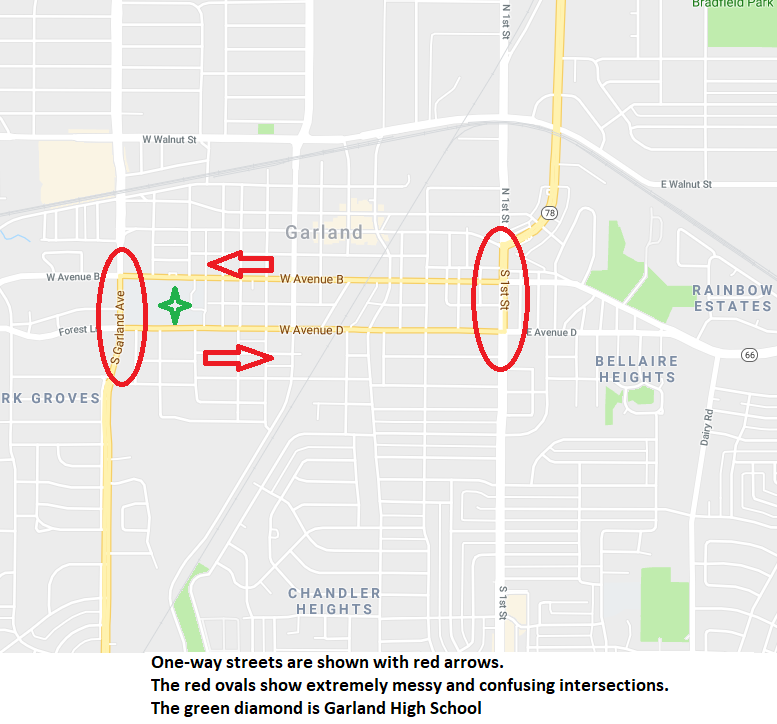
—–
As I was writing this post, another blogger hit the net with a different point of view on the SH78 issue that council recently worked on. My post is a higher level view of that issue, and only partially touches on the concerns expressed in that blog. I’d like to acknowledge that I do not have a full understanding of the history of the movement to consider realigning 78, and I can only look at today and the future.
—–
I’d like to start with a disclaimer. I do not have a background in transportation. Everything I’ve learned about regional mobility has been in the past 3-4 years, which means that I’ve learned what I know in a very heavily-politicized environment. While I’ll try to fairly present the ideas that back various strategies, the validity of those ideas is always up for debate. This article will be an attempt to present the Lavon/78 realignment in a way that makes sense to the casual reader as to why we’re even looking at it to begin with. I’ll start from the regional view, and then zoom into the local level.
Regional – East
State Hwy 78, also known as Lavon, Avenues B and D, and S Garland Avenue bisects the city, cutting through the southern end of the downtown area. It connects SH190 and IH635.

To understand the Regional Transportation Council (RTC), North Central Texas Council of Governments (NCTCOG), and Texas Dept of Transportation’s (TXDoT) driving force for wanting a SH78 realignment, you have to look at the primary reason behind it from a regional perspective. That starts northeast of the city and spans multiple counties.

The ‘Blacklands Corridor’ project was a proposal that was given strong consideration by regional, state and federal entities several years ago. It was eventually shelved due to funding/tolling/right of way concerns. The important piece to note is where the project would have ended on the west end at SH-190. There was very heavy discussion about realigning SH78 to intersect with the toll road, allowing for direct access down to IH-635 through Garland.
Regional – North
The other influential project is the Collin County outer loop project, shown below:

While this is an older image and somewhat out of date, the purple star shows where a few of the proposed termination points would be at the current SH 78 at the north end of Garland.
Regional – South and West
From the South end, we look at the connectivity from IH-635 up through Garland. In a presentation to the council a few months ago, RTC staff told us that there are formulas used to establish best practices for corridors that connect major freeways. And I’m heavily paraphrasing here, but we were told that from IH-635 to IH-30, we really ought to have 2 connectors between IH-635 and SH-190, not just one (SH 78). [My apologies to the RTC if I’ve completely mangled what you were saying, but I think we understood the basic message].
The distance from the high five interchange to SH78 is about 9 miles. The distance to IH30 from SH78 is another 3.5. I don’t believe that any agency including the city of Garland is interested in building another major North-South thoroughfare, but there are many indications that our city has to deal with a bit more arterial traffic than what might be optimal. The RTC and Dallas County have both recently made major commitments to improving Shiloh Rd (mapped below in red), which fits into the North-South needs that they have identified.

So for those regional reasons, TXDoT has started a feasibility study and started including stakeholders so they can determine if a project is even appropriate at this time. There are no discussions of timelines or funding at this point.
Now, looking at the local level we have a completely different issue.
Local

The state highway has what is referred to as a ‘couplet’ design. The road splits off into two one-way streets that cut through the southern end of downtown. This has proven to be a terrible idea in practice for this specific location.
Why Couplets?
Couplets do have their uses. With unopposed left and right turns, easier spacing of traffic control devices and better handling of mass transit, they can be incredibly effective when strategically placed. They fail in three ways in our downtown:
- Instead of contributing to our local economy, the roads bypass it.
- A state highway now runs on two sides of a high school.
- The couplet makes more sense if the state highway is SH66 (east-west), but makes no sense at all for SH78 (north-south). So guiding traffic from the north-south into an east-west cut-over and then back to north-south is extremely confusing and slow. When you add in occasional traffic congestion for passenger rail on Garland Rd and freight rail on First St, it makes rush hour that much worse.
Routes
My first official involvement with this plan was in 2017 at the Council’s winter retreat. TXDoT gave us an idea of the many, many routes that were on the table with an engineering study of which routes were physically possible. We looked at possibilities that ranged from abandoning 78 proper altogether and running the state highway down a different arterial, to one design that crossed the railroad on three separate occasions with $20M bridges and flyovers; again, all options were on the table.
We’ve looked at this a few more times since then. Each time TXDoT has eliminated more and more of the non-viable routes and now I believe we’re down to roughly a dozen variants of four main ideas:

(Image is from the 2/18 council work session transportation update).
Questions
There are a number of major questions yet to answer:
- What will the impact be to residents? We’d likely have to bulldoze homes to make this happen. Because eminent domain really is a tool of last resort, does it make sense to put the community in that position?
- With the termination of the Blacklands Corridor project, does it make sense to continue the SH78 realignment from the regional perspective; especially since these are state taxpayer dollars, not local?
- What is the final plan for the Collin County Outer Loop? Should we wait to see where it will terminate before we commit to a plan for SH78?
- Will the economic impact be more positive or negative for the city? Are we simply providing a faster way ‘through’ Garland or are we actually encouraging people to visit our economic zones?
- Since this isn’t in any of TXDoTs formal future funding plans, how realistic is it that this project will be done?
- Do we want to route a state highway down Glenbrook? What affect will that have on neighborhoods?
- In our struggle to build more walkable communities, do we focus on optimizing the traffic flow on the highway, eliminating the couplets, or should we instead focus more on alternate forms of transportation that involve less pavement? Can we do all three?
- Should we focus more of our time and money on Shiloh Rd to help alleviate traffic from SH78?
- If we don’t act, what is the long term impact on the couplet area?
As of today I have way more questions than I have answers. And it is entirely possible that no one can answer some of the more abstract questions.
Now to pick up on the points that others have touched on.
- TXDoT has provided a worst-case estimate of $100M for the project due to bridges and interaction with the railroads.
- There are no economic guarantees. Easier navigation through key intersections might have a favorable impact on our local economy. It could also end up being an express lane through the city to get to other destinations. Economic development is more complex than just one road, but transportation is a key point in any economic project. The key to success would be in developing the areas along 78 as destinations instead of way points. That goes far beyond the scope of this humble blog post, but it is definitely something that we keep in the back of our minds.
- While this council has been less than enthusiastic about sinking a large amount of time and effort into this project, Council leadership counseled us on Monday night to have patience and to let the state’s process play out. At the end of it, even if we decide that strategically it does or does not make sense to do the project now, we’ll have the study done so that all of the participating governmental entities can pull the trigger on the project much faster and with a better idea of required funding. I believe that council leadership is correct, and I am happy to let the process continue.
Conclusions
Based on the growth rate in North Central Texas, regional transportation needs will continue to grow for the foreseeable future. The SH78 has both regional and local impacts. Since the state’s taxpayers would foot the bill for this type of project, I look to regional appropriateness first, followed by the benefits to our city.
I would personally like to see the termination point of the Collin County Outer Loop determined prior to deciding where we want to anchor the northern-most point of SH 78. I’d like to see ground broken on the new IH-635 (June 2019) so we know where we’re anchoring at the southern end. We need a better idea of the proposed route impacts, and how we’ll interact with railroads and the cemeteries near Miller Rd.
A study is a good thing, and citizen involvement is even better. However, funding timelines are questionable until other transportation projects in the region are finalized. We’ll continue to plug away at it, and update you as new milestones are in sight.